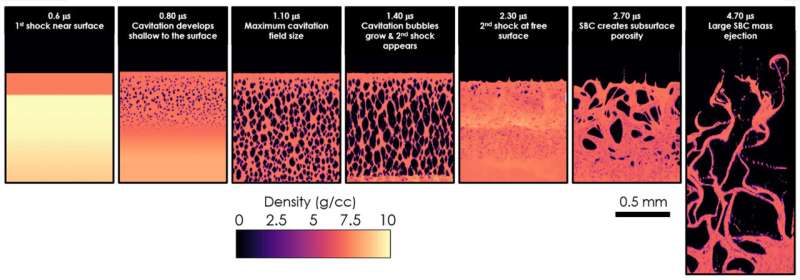This article has been reviewed according to Science X's editorial process and policies. Editors have highlighted the following attributes while ensuring the content's credibility:
fact-checked
peer-reviewed publication
trusted source
proofread
Collapsing bubbles show new ejecta production mechanism can occur under multiple-shock conditions

New research led by Lawrence Livermore National Laboratory (LLNL) provides a better understanding of ejecta production, which has been the subject of broad interest for more than 60 years throughout the scientific community.
Ejecta are particles of material forced out or ejected from an area. The phenomena are observed across many multi-disciplinary applications, including volcanic eruptions, asteroid impacts on planets, surface shielding on spacecrafts and satellites, engineering applications for powder spraying and laser-induced material ablation.
Garry Maskaly, lead author of a paper featured in the Journal of Applied Physics, said the research team identified a previously unknown ejecta production mechanism called Shallow Bubble Collapse (SBC) that is not based on Richtmyer-Meshkov instabilities (RMI), when shock waves interact with and separate two fluids of different density. RMI ejecta previously have been believed to be the main source of shock-driven metal ejecta and have been the subject of decades of research.
The work was an interactive process between computational and experimental efforts that would not have been possible without a vibrant collaboration between LLNL, Los Alamos National Laboratory (LANL), and Nevada National Security Site's Special Technologies Laboratory (NNSS-STL) in Santa Barbara, California.
The team used high-resolution modeling of various shock conditions to identify regimes that behaved computationally different than RMI-theory. The team designed and fielded experiments to evaluate those conditions. WSC codes and LLNL HPC resources were vital for this work.
The work solidifies the tight collaboration amongst LLNL, LANL, and NNSS-STL, pushing forward a new area of ejecta physics. Shock-driven ejecta production from metal surfaces often occurs in high-explosive-driven experiments with metal free surfaces.
"Understanding this phenomenon is important to accurately understand the dynamic behavior of metals in these scenarios," Maskaly said. "Metal ejecta can interfere with diagnostics and change the overall evolution of the system. In multiple shock ejecta experiments, anomalous results have been observed that were not consistent with standard RMI theory. SBC presents a new phenomenology of multi-shock ejecta production."
The key highlights from this research summarized how the SBC mechanism can produce substantially more ejecta (10 times) with a much higher temperature (two times) than RMI ejecta produced under similar shock strengths.
"The results of this research are leading to new insights in physical phenomenon in the field of ejecta physics and production, transport and various mechanisms of interactions and collisions of the SBC jets," Maskaly said.
He explained that when a metal is melted on a shock and there is a release forming cavitation bubbles near the surface, a second shock can recompact those cavitation bubbles, extracting substantial energy from the second shock.
"This causes the material to become very hot and violently explode, spraying large quantities of material in front of the surface at high velocities," Maskaly said.
Fady Najjar, a co-author of the paper, explained further: "Consider a metal sample being impacted on its back side by a fast-moving projectile. The front side is defined as the free surface (interface of sample with air).
"Once impact occurs, a shock propagates through the sample and reaches the free surface," Najjar said. "This is called a Taylor wave. Depending on the strength of the shock and the state of the sample (melted or solid), matter is ejected from that free surface which generates particulates, and we call them ejecta."
Maskaly compared the work to a common party trick where the bottom of a bottle can be broken using just your hands to hit the open mouth of the bottle.
"In this work, the formation and subsequent collapse of cavitation bubbles is violent enough to break the bottom out of a glass bottle with a moderate force," he said. "In shallow bubble collapse, the formation and shock-driven collapse of cavitation bubbles results in a violent event that results in substantial quantities of metal sprayed forward from the surface."
Maskaly said that SBC explains a regime of multiple shock-driven ejecta behaviors that were previously either unexplained or unexplored. With SBC, the team demonstrates that enough momentum is ejected that the bulk hydrodynamics can be impacted.
"Our work on SBC also has inspired diagnostic improvements for momentum measurements that are impacting future fundamental experiments and subcritical experiments," Maskaly said.
In addition to Maskaly and Najjar, co-authors include Gerald Stevens, Brandon La Lone, Dale Turley, and Matt Staska from NNSS STL; and Tom Hartsfield from LANL.
More information: G. R. Maskaly et al, Non-Richtmyer–Meshkov instability ejecta production based on shallow bubble collapse, Journal of Applied Physics (2023). DOI: 10.1063/5.0132256
Journal information: Journal of Applied Physics
Provided by Lawrence Livermore National Laboratory





















